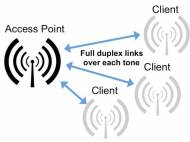True full-duplex two-way wireless connectivity developed
 Current wireless systems don’t allow the data to be sent and received in the same time over the same frequency. That’s because the strength of the transmission overwhelms any incoming signal on the same frequency. In order to increase the bandwidth and quality of data transfer, a group of engineers from the University of Waterloo developed a technology which enables wireless signals to be sent and received at the same time on a single radio channel frequency.
Current wireless systems don’t allow the data to be sent and received in the same time over the same frequency. That’s because the strength of the transmission overwhelms any incoming signal on the same frequency. In order to increase the bandwidth and quality of data transfer, a group of engineers from the University of Waterloo developed a technology which enables wireless signals to be sent and received at the same time on a single radio channel frequency.
“This means wireless companies can increase the bandwidth of voice and data services by at least a factor of two by sending and receiving at the same time, and potentially by a much higher factor through better adaptive transmission and user management in existing networks”, said Amir K. Khandani, a Waterloo electrical and computer engineering professor who led the research.
In contrast to the widely accepted beliefs, it is shown that two-way wireless is not only possible, but is fairly simple, with virtually no degradation in signal-to-noise-ratio. More importantly, it is shown that two-way wireless can do much more than just doubling the rate. The Waterloo engineering research breakthrough is based on Interference Alignment technology patented by Khandani in 2006 and issued in 2010.
Unlike engineering researchers from Rice University who re-purposed multiple-input, multiple outputs (MIMO) antenna technology, the innovation is in the antenna design and multiple levels for cancelling self-interference. Methods developed by Waterloo engineers are suitable for use with multiple antenna (MIMO) two-way transmission, as well as asynchronous two-way links which are useful in networking applications.
Thy system’s hardware can be made from off-the-shelf components, and its antennas are omnidirectional, do not suffer from bandwidth limitations, have a simple structure which leads to their relatively small size (comparable to current one-way systems), and enable signal processing complexity. The introduction of signal processing complexity could lead to media-based wireless communication – a wireless communication based on embedding data in the transmission media by changing its RF properties in contrast to embedding data in the transmitted signal.
The video clip also introduces many new applications for two-way technology such as methods for interference management, security enhancement. Media-based approach offers significant benefits compared to traditional MIMO systems even with a smaller number of antennas.
“The cost in hardware and signal processing complexities and antenna size is very low and virtually the same as current one-way systems. Two-way wireless systems will also have a profound impact on wireless networks in terms of quality of service and efficiency”, said Khandani.
If these findings become accepted by the industry which dictates the standards and their implementation, these could ensure improvements in wireless transmission, networking and security in not so distant future.
If you want to read the whole presentation on your own, you can read the complete “Two-Way Wireless” presentation here [4.3MB PDF]. For related videos and narated presentation, visit the Two-way (True Full-duplex) Connectivity: The Future of Wireless project page.









Leave your response!